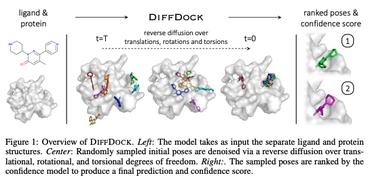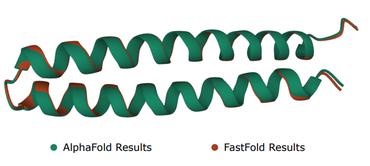Search Results for author: Bonnie Berger
Found 17 papers, 11 papers with code
Dirichlet Flow Matching with Applications to DNA Sequence Design
1 code implementation • 8 Feb 2024 • Hannes Stark, Bowen Jing, Chenyu Wang, Gabriele Corso, Bonnie Berger, Regina Barzilay, Tommi Jaakkola
Further, we provide distilled Dirichlet flow matching, which enables one-step sequence generation with minimal performance hits, resulting in $O(L)$ speedups compared to autoregressive models.
AlphaFold Meets Flow Matching for Generating Protein Ensembles
1 code implementation • 7 Feb 2024 • Bowen Jing, Bonnie Berger, Tommi Jaakkola
When trained and evaluated on the PDB, our method provides a superior combination of precision and diversity compared to AlphaFold with MSA subsampling.
Equivariant Scalar Fields for Molecular Docking with Fast Fourier Transforms
1 code implementation • 7 Dec 2023 • Bowen Jing, Tommi Jaakkola, Bonnie Berger
The runtime of our approach can be amortized at several levels of abstraction, and is particularly favorable for virtual screening settings with a common binding pocket.
EigenFold: Generative Protein Structure Prediction with Diffusion Models
1 code implementation • 5 Apr 2023 • Bowen Jing, Ezra Erives, Peter Pao-Huang, Gabriele Corso, Bonnie Berger, Tommi Jaakkola
Protein structure prediction has reached revolutionary levels of accuracy on single structures, yet distributional modeling paradigms are needed to capture the conformational ensembles and flexibility that underlie biological function.
Causally-guided Regularization of Graph Attention Improves Generalizability
no code implementations • 20 Oct 2022 • Alexander P. Wu, Thomas Markovich, Bonnie Berger, Nils Hammerla, Rohit Singh
Graph attention networks estimate the relational importance of node neighbors to aggregate relevant information over local neighborhoods for a prediction task.
Granger causal inference on DAGs identifies genomic loci regulating transcription
1 code implementation • ICLR 2022 • Rohit Singh, Alexander P. Wu, Bonnie Berger
When a dynamical system can be modeled as a sequence of observations, Granger causality is a powerful approach for detecting predictive interactions between its variables.
Enriching and Characterizing T-Cell Repertoires from 3' Barcoded Single-Cell Whole Transcriptome Amplification Products
no code implementations • 21 Mar 2022 • Tasneem Jivanjee, Samira Ibrahim, Sarah K. Nyquist, G. James Gatter, Joshua D. Bromley, Swati Jaiswal, Bonnie Berger, Samuel M. Behar, J. Christopher Love, Alex K. Shalek
In short, a fraction of the 3' barcoded whole transcriptome amplification (WTA) product typically used to generate a massively parallel 3' scRNA-seq library is enriched for TCR transcripts using biotinylated probes, and further amplified using the same universal primer sequence from WTA.
Exploring generative atomic models in cryo-EM reconstruction
no code implementations • 3 Jul 2021 • Ellen D. Zhong, Adam Lerer, Joseph H. Davis, Bonnie Berger
Although reconstruction algorithms typically model the 3D volume as a generic function parameterized as a voxel array or neural network, the underlying atomic structure of the protein of interest places well-defined physical constraints on the reconstructed structure.
Multi-resolution modeling of a discrete stochastic process identifies cusses of cancer
no code implementations • ICLR 2021 • Adam Uri Yaari, Maxwell Sherman, Oliver Clarke Priebe, Po-Ru Loh, Boris Katz, Andrei Barbu, Bonnie Berger
Detection of cancer-causing mutations within the vast and mostly unexploredhuman genome is a major challenge.
CryoDRGN2: Ab Initio Neural Reconstruction of 3D Protein Structures From Real Cryo-EM Images
no code implementations • ICCV 2021 • Ellen D. Zhong, Adam Lerer, Joseph H. Davis, Bonnie Berger
In this work we describe cryoDRGN2, an ab initio reconstruction algorithm, which can jointly estimate image poses and learn a neural model of a distribution of 3D structures on real heterogeneous cryo-EM data.
Learning Mutational Semantics
1 code implementation • NeurIPS 2020 • Brian Hie, Ellen Zhong, Bryan Bryson, Bonnie Berger
In many natural domains, changing a small part of an entity can transform its semantics; for example, a single word change can alter the meaning of a sentence, or a single amino acid change can mutate a viral protein to escape antiviral treatment or immunity.
Explicitly disentangling image content from translation and rotation with spatial-VAE
1 code implementation • NeurIPS 2019 • Tristan Bepler, Ellen D. Zhong, Kotaro Kelley, Edward Brignole, Bonnie Berger
Given an image dataset, we are often interested in finding data generative factors that encode semantic content independently from pose variables such as rotation and translation.
Reconstructing continuous distributions of 3D protein structure from cryo-EM images
2 code implementations • ICLR 2020 • Ellen D. Zhong, Tristan Bepler, Joseph H. Davis, Bonnie Berger
Cryo-electron microscopy (cryo-EM) is a powerful technique for determining the structure of proteins and other macromolecular complexes at near-atomic resolution.
Learning protein sequence embeddings using information from structure
1 code implementation • ICLR 2019 • Tristan Bepler, Bonnie Berger
We introduce a framework that maps any protein sequence to a sequence of vector embeddings --- one per amino acid position --- that encode structural information.
Large-Margin Classification in Hyperbolic Space
2 code implementations • 1 Jun 2018 • Hyunghoon Cho, Benjamin DeMeo, Jian Peng, Bonnie Berger
Representing data in hyperbolic space can effectively capture latent hierarchical relationships.
Positive-unlabeled convolutional neural networks for particle picking in cryo-electron micrographs
1 code implementation • 22 Mar 2018 • Tristan Bepler, Andrew Morin, Julia Brasch, Lawrence Shapiro, Alex J. Noble, Bonnie Berger
Cryo-electron microscopy (cryoEM) is an increasingly popular method for protein structure determination.
Diffusion Component Analysis: Unraveling Functional Topology in Biological Networks
no code implementations • 10 Apr 2015 • Hyunghoon Cho, Bonnie Berger, Jian Peng
In this paper, we introduce diffusion component analysis (DCA), a framework that plugs in a diffusion model and learns a low-dimensional vector representation of each node to encode the topological properties of a network.









